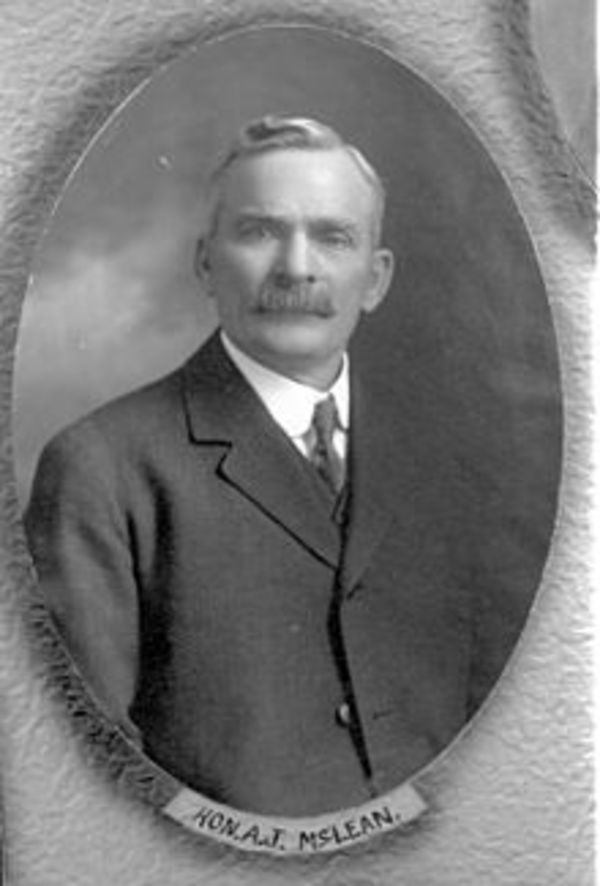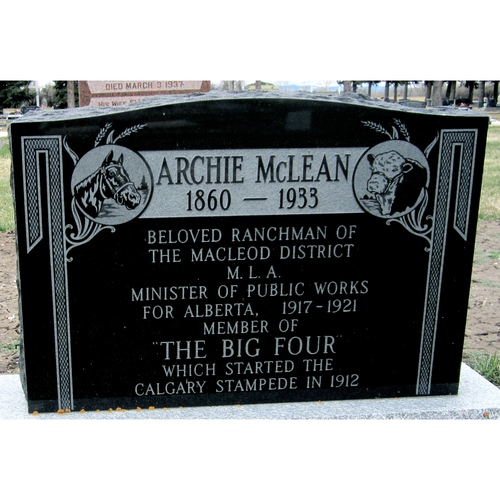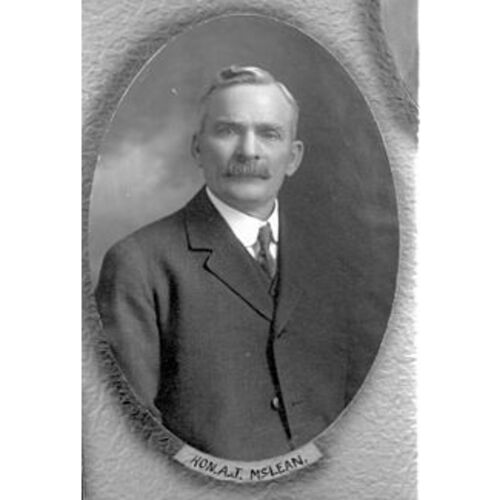
Source: Courtesy of Wikimedia Commons
McLEAN, ARCHIBALD JAMES, rancher, politician, and businessman; b. 25 Sept. 1860 in Aldborough Township, Upper Canada, one of the six children of James McLean and Clementine McMurchy, farmers; m. 15 Dec. 1904 Margaret E. Duncan in Hamilton, Ont., and they had a son; d. 13 Oct. 1933 in Fort Macleod, Alta.
Archibald J. McLean attended school in Aldborough and learned the farming business there. A Presbyterian, he was an early member of McColl masonic lodge in West Lorne. In 1881 he moved to Manitoba and established a farming and livestock operation in the Virden district south of Pipestone Creek. For five years he derived his main income from buying horses in Ontario and selling them to farmers in the Pipestone area. During this time he befriended cattleman Patrick Burns and financier Augustus Meredith Nanton*, who were to make their mark farther west, in Alberta.
McLean relocated in 1886 to the Alberta district, where he gained experience as a range rider, cowboy, and ranch foreman. He then became manager and later owner of the CY Ranch northwest of Taber. While at the CY, he formed the company of Bater and McLean in London to negotiate the export and sale of cattle in Britain. At age 44 he married Margaret Duncan, who died in Lethbridge two years later giving birth to their only child. His link to Taber would be consolidated by his start-up of the Taber Times in 1911.
In 1909, after the creation of Alberta as a province, McLean was persuaded to enter provincial politics as an independent Liberal for the Lethbridge District constituency. Following Arthur Lewis Watkins Sifton*’s elevation as premier in May 1910, McLean entered his cabinet as provincial secretary on 1 June and was acclaimed in a by-election. He was returned with large majorities for the seat of Taber in 1913 and again in 1917, when Sifton was succeeded by Charles Stewart*. McLean’s political career ended with his defeat in the landslide victory of the United Farmers of Alberta in 1921. During his tenure he had held three cabinet positions: provincial secretary (until 15 Oct. 1917), minister of municipal affairs (20 Dec. 1911 to 3 May 1912), and minister of public works (16 Oct. 1917 to 12 Aug. 1921). In office, McLean, known widely as “Honest Archie,” was regarded as an extremely capable administrator. He was given credit for sponsoring the 1915 legislation that allowed farmers formally to organize irrigation districts. McLean was involved in the establishment and financing of the Taber Irrigation District in the spring of that year. As minister of public works, he was seen as a creative influence in the building of Alberta’s highway system.
After 1921 McLean returned to cattle ranching. For the next decade he worked 18,000 acres of leased land in the Peigan Indian Reserve near Fort Macleod. He would continue to manage this spread following its takeover by a large stock company in 1932. In the late 1920s he was appointed by the Dominion Bank to oversee the dispersion and sale of several properties belonging to the estate of rancher George Lane*, who had died in 1925. Among those sold, to Patrick Burns, were the famous Bar U and Flying E ranches and Namaka Farms. McLean managed Namaka for a time. In October 1933 he fell ill while returning to Calgary from Fort Macleod. He died in hospital a few days later. The one-and-a-half-mile cortège made his funeral one of the largest ever seen in southern Alberta; it was attended by prominent members of the ranching community, senior Canadian Pacific Railway officials, three federal senators, and several provincial politicians. He was buried in the Fort Macleod cemetery with full masonic rites. In 1963 he was elected to the Canadian Agricultural Hall of Fame.
Archie McLean contributed to Alberta’s early life in many ways. Besides being a successful rancher, he was a versatile businessman who, like many others of his time, was prepared to invest outside his area of expertise. He was active in the fledgling coal-mining and oil industries; at the time of his death he was connected with oil prospects along the international boundary in southern Alberta. Yet, despite his business acumen, his political reputation, and the high esteem he gained in ranching circles, he is best remembered for a single gesture.
McLean was one of the cattlemen known as the Big Four who guaranteed $100,000 to stage the first Calgary Stampede in 1912 and its successor, the “Great Victory Stampede,” seven years later. Together with Burns, Lane, and Alfred Ernest Cross, he pledged $25,000 to ensure the financial viability of the grand design of showman Guy Weadick* to replace the artificiality of the wild west show with the authenticity of a western Canadian frontier celebration wedded to a world-class rodeo. McLean continued his commitment to the Stampede in later years as a director and board member. Described in Canadian Cattlemen (Calgary) in 1941 as “the man who never made a million dollars but who did make a million friends,” Archie McLean the rancher and politician was a formative force in the early development of Alberta. As a member of the Big Four, he has ensured his immortality.
Alta Legislature Library (Edmonton), “Alta cabinets”; “Biog. reg. of the Alta Legislature, fourth legislature, February 7, 1918–April 19, 1921.” AO, RG 80-5-0-331, no.19660. Albertan (Calgary), 3 Jan. 1962. Calgary Albertan, 14 Oct. 1933. Calgary Herald, 23 Oct. 1933, 3 Sept. 1955. Lethbridge Herald (Lethbridge, Alta), 13 Oct. 1933. Medicine Hat News (Medicine Hat, Alta), 19 Oct. 1933. Nanton News (Nanton, Alta), 19 Oct. 1933. Alberta newspapers, 1880–1982: an historical directory, comp. G. M. Strathern (Edmonton, 1988). S. M. Evans, The Bar U & Canadian ranching history (Calgary, 2004). Golden jubilee: commemorating fifty years of picture history of Taber, Alberta, 1905–1955 ([Taber, Alta, 1956]). J. H. Gray, A brand of its own: the 100 year history of the Calgary Exhibition and Stampede (Saskatoon, 1985). C. I. Ritchie, “‘Archie’ McLean – pioneer administrator – one of the ‘Big Four,’” Canadian Cattlemen (Calgary), 3 (1940–41): 504, 528–29, 532–33.
Cite This Article
Max Foran, “McLEAN, ARCHIBALD JAMES,” in Dictionary of Canadian Biography, vol. 16, University of Toronto/Université Laval, 2003–, accessed December 20, 2025, https://www.biographi.ca/en/bio/mclean_archibald_james_16E.html.
The citation above shows the format for footnotes and endnotes according to the Chicago manual of style (16th edition). Information to be used in other citation formats:
| Permalink: | https://www.biographi.ca/en/bio/mclean_archibald_james_16E.html |
| Author of Article: | Max Foran |
| Title of Article: | McLEAN, ARCHIBALD JAMES |
| Publication Name: | Dictionary of Canadian Biography, vol. 16 |
| Publisher: | University of Toronto/Université Laval |
| Year of publication: | 2014 |
| Year of revision: | 2014 |
| Access Date: | December 20, 2025 |





